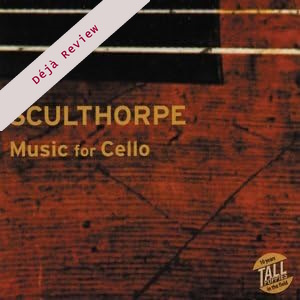
Déjà Review: this review was first published in June 2003 and the recording is still available.
Peter Sculthorpe (1929-2014)
Music for Cello
David Pereira (cello)
Ian Munro (piano)
rec. 1998/99, Llewellyn Hall, Canberra School of Music; Concert Hall, Newcastle Conservatorium of Music, Australia
Tall Poppies TP136 [69]
Peter Sculthorpe, the great Tasmanian born Australian composer, is someone whose music I have listened to with ever-increasing interest since my first encounter on an early Kronos Quartet LP. His is a multi-faceted art: aboriginal music and myth, and the nature mysticism/folk naivete of early Mahler. He also draws on Pacific Rim influences – no doubt encouraged not only by his homeland’s geographical and cultural legacy but also by his studies in Britain with Edmund Rubbra. It is a potent, indeed magnetic, and generally accessible brew. This disc, one in a series celebrating Tall Poppies’ tenth anniversary, offers us an overview of Sculthorpe’s output for cello. It gives an excellent insight into where he is coming from, artistically speaking. It also has the advantage of featuring one of the composer’s favourite instruments.
The disc begins with the single movement Sonata which makes clear the Mahlerian influence. That said, there is never, here as in any Sculthorpe, any danger of his always supremely lucid artistic vision being clouded by the extreme pathos or, alternatively, the bombast that afflicts some of Mahler’s work. Sculthorpe’s ideal conception of Mahler, very much like my own, is that of the child wandering carefree in Alpine meadows (see the second volume of the Sculthorpe string quartets, for more specific references). The following Requiem draws heavily on plainchant and distils deep emotional currents. There are echoes here of James MacMillan or even John Tavener’s more austere inspirations, e.g. Eternal Memory. In contrast, Djilile is based on an aboriginal chant about a “whistling duck on a billabong (watering hole)”. It has appeared in several guises – I was already familiar with the solo piano version but the cello certainly adds something extra. It is a subdued but truly haunting piece of music and is typical of Sculthorpe in that, without resort to any histrionics whatsoever, it perfectly captures the wild strangeness of the Australian outback.
The Tailitnama Song, again an aboriginal inspiration, appears here in two versions, one with piano and one without. Again it is rooted in the natural surroundings which generated it and is equally poetic in either incarnation. The song it is based on concerns “the glowing of the mountains” and “the coming of the dawn” which should give the uninitiated a good idea of what Sculthorpe’s muse is driven by. Nature is writ large but not, in any sense, in a twee or sanitised way. If you are looking for comparisons, in intensity rather than style, Nielsen, Sibelius, Tveitt and, unsurprisingly, Lilburn spring to mind. However, Sculthorpe is very much more overtly tuned in to the Oriental, southern hemisphere, Pacific Rim mindset. Threnody is based on the orchestral work Kakadu (after the national park) and is dedicated to the memory of conductor Stuart Challender. The composer has written many works which function as laments and, as with his nature-painting, he reveals a great gift for doing so.
Into the Dreaming used to be called Cello Dreaming but now exists in alternative versions for other instruments including one for guitar (recorded by John Williams for Sony). Again it is a memorial piece for a dead friend but is also inspired by the awesome landscapes of the Uluru (Ayers Rock) national park. Again it cuts to the craw emotionally without ever descending to sentimentality. Parting is an arrangement of a song setting of Heine. It is highly appropriate that the lyrical cello is the singer here (the texts appear in the booklet). This is yet another tribute to a life cut short prematurely (the journalist Andrew Olle). The disc concludes with From Saibai, a truncated version of the excellent clarinet work Songs of Sea and Sky (also available on Tall Poppies). It typifies Sculthorpe’s recent fascination with the music of the peoples of the Torres Strait (the narrow seaway between northern Australia and Papua New Guinea), which has also inspired some of the later string quartets (Island Dreaming etc.). Like virtually everything on this disc, and in any other Sculthorpe, it sings a joyous yet realistic, accessible yet profound, song of the elements, of the natural world and the people who live in close proximity to it.
David Pereira proves, as on other Tall Poppies recitals, that he is a world class cellist, in this case ably accompanied by Ian Munro. Belinda Webster’s vision as a recording engineer is among the most astute in the world. This CD, a 70th birthday tribute (in 1999) to Peter Sculthorpe, is among the most satisfying of modern chamber recordings I have ever heard and a true work of art. Recommended without reservation.
Neil Horner
Buying this recording via a link below generates revenue for MWI, which helps the site remain free


Contents
Sonata for Cello Alone (1959)
Requiem, for cello alone (1979)
Djilile, for cello and piano (1986)
Tailitnama Song, for cello and piano (1989)
Threnody, for solo cello (1991)
Into the Dreaming, for cello alone (1993)
Parting, for cello and piano (1995)
Tailitnama Song, for cello solo (1997)
From Saibai, for cello and piano (1997)

















